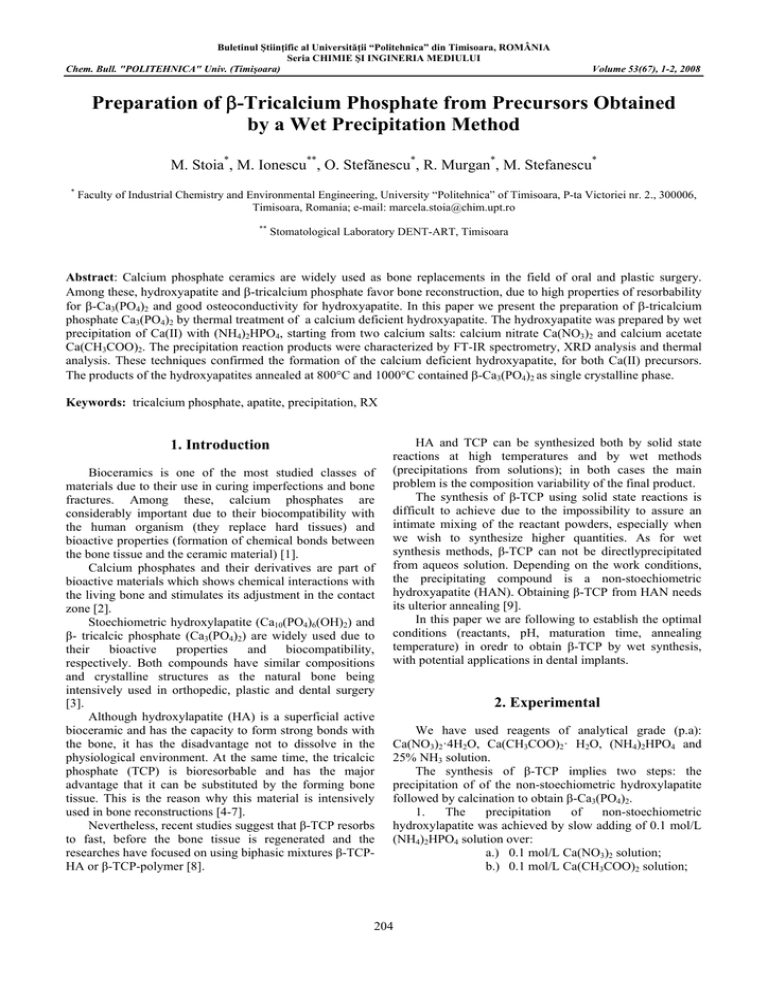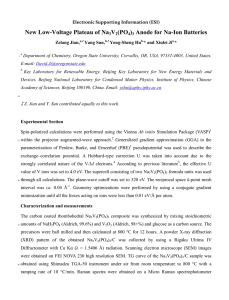Document 13359655
advertisement

Buletinul Ştiinţific al Universităţii “Politehnica” din Timisoara, ROMÂNIA Seria CHIMIE ŞI INGINERIA MEDIULUI Chem. Bull. "POLITEHNICA" Univ. (Timişoara) Volume 53(67), 1-2, 2008 Preparation of β-Tricalcium Phosphate from Precursors Obtained by a Wet Precipitation Method M. Stoia*, M. Ionescu**, O. Stefănescu*, R. Murgan*, M. Stefanescu* * Faculty of Industrial Chemistry and Environmental Engineering, University “Politehnica” of Timisoara, P-ta Victoriei nr. 2., 300006, Timisoara, Romania; e-mail: marcela.stoia@chim.upt.ro ** Stomatological Laboratory DENT-ART, Timisoara Abstract: Calcium phosphate ceramics are widely used as bone replacements in the field of oral and plastic surgery. Among these, hydroxyapatite and β-tricalcium phosphate favor bone reconstruction, due to high properties of resorbability for β-Ca3(PO4)2 and good osteoconductivity for hydroxyapatite. In this paper we present the preparation of β-tricalcium phosphate Ca3(PO4)2 by thermal treatment of a calcium deficient hydroxyapatite. The hydroxyapatite was prepared by wet precipitation of Ca(II) with (NH4)2HPO4, starting from two calcium salts: calcium nitrate Ca(NO3)2 and calcium acetate Ca(CH3COO)2. The precipitation reaction products were characterized by FT-IR spectrometry, XRD analysis and thermal analysis. These techniques confirmed the formation of the calcium deficient hydroxyapatite, for both Ca(II) precursors. The products of the hydroxyapatites annealed at 800°C and 1000°C contained β-Ca3(PO4)2 as single crystalline phase. Keywords: tricalcium phosphate, apatite, precipitation, RX 1. Introduction Bioceramics is one of the most studied classes of materials due to their use in curing imperfections and bone fractures. Among these, calcium phosphates are considerably important due to their biocompatibility with the human organism (they replace hard tissues) and bioactive properties (formation of chemical bonds between the bone tissue and the ceramic material) [1]. Calcium phosphates and their derivatives are part of bioactive materials which shows chemical interactions with the living bone and stimulates its adjustment in the contact zone [2]. Stoechiometric hydroxylapatite (Ca10(PO4)6(OH)2) and β- tricalcic phosphate (Ca3(PO4)2) are widely used due to their bioactive properties and biocompatibility, respectively. Both compounds have similar compositions and crystalline structures as the natural bone being intensively used in orthopedic, plastic and dental surgery [3]. Although hydroxylapatite (HA) is a superficial active bioceramic and has the capacity to form strong bonds with the bone, it has the disadvantage not to dissolve in the physiological environment. At the same time, the tricalcic phosphate (TCP) is bioresorbable and has the major advantage that it can be substituted by the forming bone tissue. This is the reason why this material is intensively used in bone reconstructions [4-7]. Nevertheless, recent studies suggest that β-TCP resorbs to fast, before the bone tissue is regenerated and the researches have focused on using biphasic mixtures β-TCPHA or β-TCP-polymer [8]. HA and TCP can be synthesized both by solid state reactions at high temperatures and by wet methods (precipitations from solutions); in both cases the main problem is the composition variability of the final product. The synthesis of β-TCP using solid state reactions is difficult to achieve due to the impossibility to assure an intimate mixing of the reactant powders, especially when we wish to synthesize higher quantities. As for wet synthesis methods, β-TCP can not be directlyprecipitated from aqueos solution. Depending on the work conditions, the precipitating compound is a non-stoechiometric hydroxyapatite (HAN). Obtaining β-TCP from HAN needs its ulterior annealing [9]. In this paper we are following to establish the optimal conditions (reactants, pH, maturation time, annealing temperature) in oredr to obtain β-TCP by wet synthesis, with potential applications in dental implants. 2. Experimental We have used reagents of analytical grade (p.a): Ca(NO3)2·4H2O, Ca(CH3COO)2· H2O, (NH4)2HPO4 and 25% NH3 solution. The synthesis of β-TCP implies two steps: the precipitation of of the non-stoechiometric hydroxylapatite followed by calcination to obtain β-Ca3(PO4)2. 1. The precipitation of non-stoechiometric hydroxylapatite was achieved by slow adding of 0.1 mol/L (NH4)2HPO4 solution over: a.) 0.1 mol/L Ca(NO3)2 solution; b.) 0.1 mol/L Ca(CH3COO)2 solution; 204 Chem. Bull. "POLITEHNICA" Univ. (Timişoara) Volume 53(67), 1-2, 2008 The volumes of the reactant solutions were calculated for a ratio Ca/P= 1.5 (corresponding to Ca3(PO4)2). The precipitation took place under continous stirring using the mecanical agitator MR-25. The reactant solutions were adjusted to pH= 9.5 with 1 mol/L NH3 solution, value which was maintaned during the entire precipitation. The precipitates obtained were left for maturation (1 h), filtered under vacuum and washed with distilled water and finally with acetone. The precipitates were dried at 60 0C for 2 h and at 105 0C for 24 h. The dried products obtained by using the two calcium precursors: Ca(NO3)2 - sample P1 and Ca(CH3COO)2 sample P2, were grinded in order to obtain white powders. 2. The samples P1 and P2 were annealed at 850°C and 1000 0C, for 8 h, to obtain white powders. The powders P1 and P2 obtained at 105 0C and annealed at 850 0C and 1000 0C, were characterized by: - XRD, using a Dron3 with Cu anode Vd= 2 0C/min, λCuα1α2= 1, 54178 Å; - FT-IR spectrometry using JASCO 430, in KBr pellets; - Derivatographic analysis using 1500D MOM Budapesta derivatograph, in air, non-isothermic, heating rate 10 0C/min, using Pt crucibles, sample mass 500,0 mg. (non-stoechiometric), confirmed by the presence of the shoulder characteristic for HPO 4− . a) b) Figure 1. FT-IR spectra of the samples dried at 105°C: P1 (spectrum a) and P2 (spectrum b) The samples P1 and P2 were studied by XRD. The XRD patterns are presented in figure 2 (a and b), compared to the XRD patterns characteristic for hidroxyapatite Ca9HPO4(PO4)5OH (ASTM 46-0905, JCPDS 1997). 3. Results and discussion According to the literature [9], even though at precipitation the ratio is Ca/P = 1.5 (corresponding to Ca3(PO4)2) within the precipitate this ratio can be different depending on the work conditions (pH, temperature, maturation time). Generally, precipitates the nonstoechiometric hydroxylapatite Ca10-x(HPO4)x(PO4)6(OH) with 0 ≤ x ≤ 1. In optimal precipitation conditions, 2-x x when the ratio inside the precipitate is Ca/P = 1.5, the precipitating compound is the calcium defficient hydroxylapatite: Ca9HPO4(PO4)5OH (HAD). J.C. Heughebaert [10] proposed a two step mechanism for the precipitation of the defficient hydroxylapatite: - Precipitation of an amorphous calcium phosphate: 9Ca 2+ + 6 PO43− → Ca9 ( PO4 ) 6 ⋅ nH 2 O - Hydrolysis of PO43− : PO43− + H 2 O → HPO42− + HO − which leads to the final product Ca9(HPO4)x(PO4)6-x(OH)x for x = 1 and Ca/P = 1.5, respectively. Figure 1 shows the FTIR spectra of the powders dried at 105°C, P1- obtained from calcium nitrate (spectrum a) and P2 – obtained from calcium acetate (spectrum b). Both spectra presents the characteristic bands for PO43: 460-474 cm-1, 570-600 cm-1, 960 cm-1, 1010-1120 cm1 [11]. The band from 632 cm-1 may be attributed to the hydroxylic group (HO-) and the shoulder from 875 cm-1 corresponds to HPO4- [12]. The bands in the range 13001500 cm-1 may be attributed to the residual groups from the synthesis ( NO3− , CH 3COO − , NH 4+ , CO 2 ). According to the presented spectra we can conclude that in both cases we obtain the same precipitation compound: calcium defficient hydroxylapatite (HAD) Figure 2. XRD patterns of the samples dried at 105°C: a) P1; b) P2; c) Ca9HPO4(PO4)5OH, ASTM 46-0905, JCPDS 1997 The XRD and FT-IR results confirm that by the used synthesis method and the established work conditions, we 205 Chem. Bull. "POLITEHNICA" Univ. (Timişoara) Volume 53(67), 1-2, 2008 obtain calcium defficient hydroxylapatite: Ca9HPO4(PO4)5OH (Ca/P = 1.5). The two products P1 and P2 obtained in the precipitation step were studied by thermal analysis, in order to establish the optimal annealing conditions to Ca3(PO4)2. Figure 3 presents the thermal curves TG and DTA ofthe sample P1 (obtained from Ca(NO3)2). The mass loss recorded until 400°C (~3%) is due to the humidity and the residual ions (NH4+, NO3-, PO43-). The thermal curves show that starting from ~750°C the apatitic phase endothermally decomposes to tricalcium phosphate [8]. Figure 3. Derivatogramm of the sample obtained starting from Ca(NO3)2·4H2O; static atmosphere air, m = 500,0 mg, 10°C/min, 20-1000°C As a result of the thermal behavior of the apatitic precursors, the annealing temperature of hydroxylapatite can be chosen in the temperature range 750-1170°C (the temperature when βTCP transforms to αTCP[12]). In order to obtain β-Ca3(PO4)2, the samples P1 and P2 (dried at 105°C) were annealed for 6 hours at 850°C and 1000°C. Figure 4 presents the XRD patterns of the powders obtained after the annealing of the samples resulted in the precipitation step. According to the literature [8], by annealing one can obtain pure β-TCP when the ratio Ca/P is 1,5; if the ratio Ca/P is higher than 1,5, one obtains, as a result of the annealing, hydroxylapatite as secondary phase (Ca10(PO4)6(OH)2), and if the ratio Ca/P is lower than 1,5, one obtains as secondary phase calcium pyrophosphate (CaP2O7). Comparing the XRD spectra of the annealed samples with the characteristic patterns ofβ-Ca3(PO4)2 (ASTM 060426, JCPDS), CaP2O7 (ASTM 41-0489, JCPDS) and Ca10(PO4)6(OH)2 (ASTM 01-1008, JCPDS), we can observe that all samples contain as unique phase β-TCP. 206 Figure 4. XRD patterns of the annealed samples: a) P1 at 1000°C, 8h; b) P2 at 1000 °C, 8h; c) P2 at 850°C, 8h d) XRD pattern of β-TCP, for medical use, fabricated byBiocomposites, Anglia e) XRD patterns characteristic to β-TCP, CaP2O7 and Ca10(PO4)6(OH)2, according to ASTM files Chem. Bull. "POLITEHNICA" Univ. (Timişoara) Volume 53(67), 1-2, 2008 REFERENCES 4. Conclusions The chosen synthesis conditions: pH = 9,5, temperature 25°C, concentrations of the reactant solutions 0,1 mol/L, assure the formation of a precipitate within the ratio Ca/P corresponds to tricalcic phosphate (1,5); the precipitating compound was calcium defficient hydroxylapatite: Ca9HPO4(PO4)5OH. According to the XRD and FT-IR analysis of the precipitation products the compound formed in the precipitation step does not differ significantly with the calcium source: Ca(NO3)2 or Ca(CH3COO)2, . According to the XRD patterns obtained for the powders annealed at the two temperatures: 850°C and 1000°C, we can observe that β-tricalcic phosphate is formed as crystalline phase starting with 850°C. The obtained material can be used as a biocompatible material with potential aplications in 1. Manjubala, I., Sivakumar, M., Mat. Chem. Phy., 2001, 71, pp. 272. 2. Burghelea, V., Popa, C., Materiale bioceramice, Materiale de construcţii, XXIII, nr.1 1993. pp. 43-46. 3. Reymond, S., Champion, E., Bernache-Assollant, D., Thomas, P., Biomaterials, 2002, 23, pp. 1065-1072. 4. Chung-King Hsu, Mat. Chem. Phy., 2002, 9470, pp. 1-12. 5. Wong, L.H., Tio, B., Miao, X., Mat. Sci.Eng. C, 2002, 20, pp. 111-115. 6. Yasuda, A.Y., Mehara, S., Mishigawa, T., Umakoshi, Y., Sci.Tech.nol. Adv. Mat, 2002, 3, pp. 29-33. 7. Ryn, H.S., Youn, H.I., Hong, K.S., Chang, B.S., Lee, C.K., Chang, S.S., Biomaterials, 2002, 23, pp. 909-914. 8. Dong, J., Uemura, T., Shirasaki, I., Tateishi, T., Biomaterials, 2002, 23, pp. 4493-4502. 9. Destainville, A., Champion, E., Bernache-Assollant, D., Laborde, E., Mat. Chem.Phy., 2003, 80, pp. 269-277. 10. Zawacki, S.J., Heughebaert, J.C., Nancollas, G.H., J. Colloid Interface Sci., 1990, 135, pp. 33-44. 11. Abdelkader, S.B., Cherifa, A.B., Khatech, I., Jemal, M., Thermoch. Acta, 1999, 334, pp. 123-129. 12. Liou, S.C., Chan, S.Y., Biomaterials, 2002, 23, pp. 4541-4547. 13. Lin, F.H., Liao, C.J., Chen, K.S., Sun, J.S., 1998, 19, pp. 1101-1107. 207


